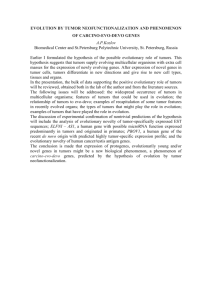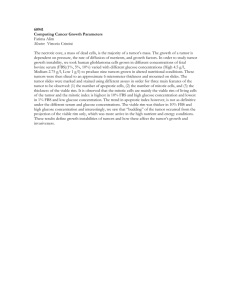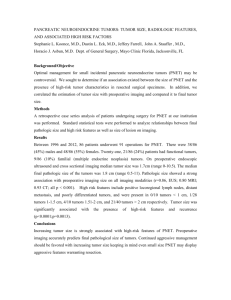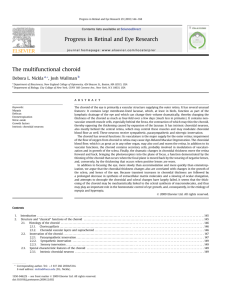COMMON INTRAOCULAR TUMORS - College of Optometry
advertisement
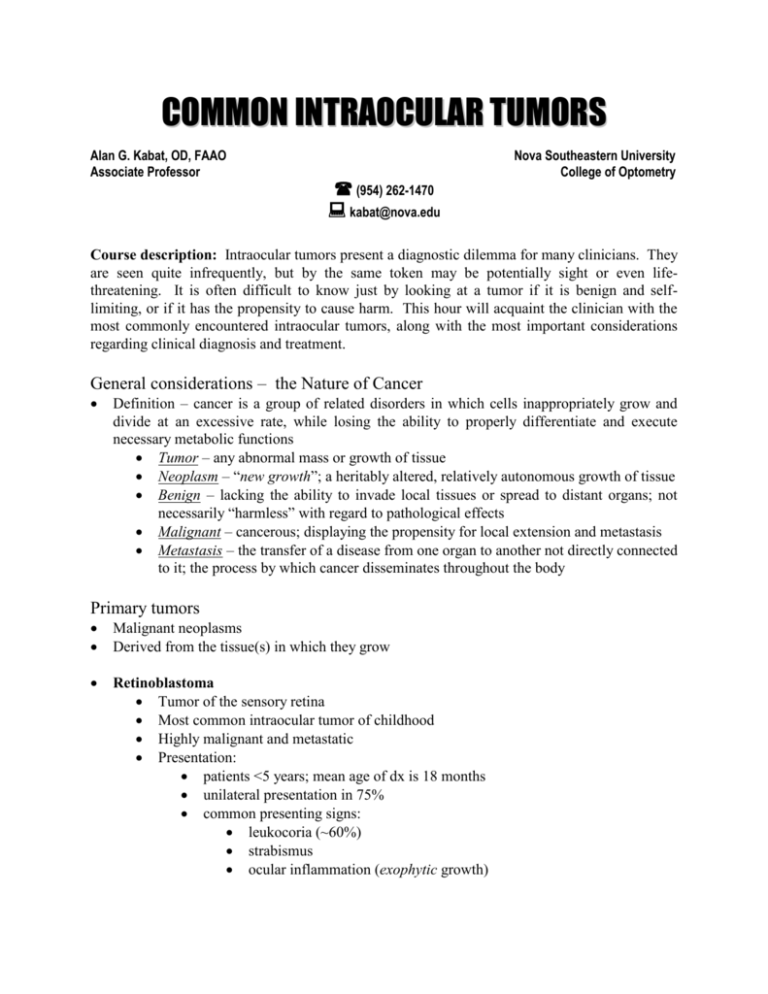
COMMON INTRAOCULAR TUMORS
Alan G. Kabat, OD, FAAO
Associate Professor
(954) 262-1470
Nova Southeastern University
College of Optometry
kabat@nova.edu
Course description: Intraocular tumors present a diagnostic dilemma for many clinicians. They
are seen quite infrequently, but by the same token may be potentially sight or even lifethreatening. It is often difficult to know just by looking at a tumor if it is benign and selflimiting, or if it has the propensity to cause harm. This hour will acquaint the clinician with the
most commonly encountered intraocular tumors, along with the most important considerations
regarding clinical diagnosis and treatment.
General considerations – the Nature of Cancer
Definition – cancer is a group of related disorders in which cells inappropriately grow and
divide at an excessive rate, while losing the ability to properly differentiate and execute
necessary metabolic functions
Tumor – any abnormal mass or growth of tissue
Neoplasm – “new growth”; a heritably altered, relatively autonomous growth of tissue
Benign – lacking the ability to invade local tissues or spread to distant organs; not
necessarily “harmless” with regard to pathological effects
Malignant – cancerous; displaying the propensity for local extension and metastasis
Metastasis – the transfer of a disease from one organ to another not directly connected
to it; the process by which cancer disseminates throughout the body
Primary tumors
Malignant neoplasms
Derived from the tissue(s) in which they grow
Retinoblastoma
Tumor of the sensory retina
Most common intraocular tumor of childhood
Highly malignant and metastatic
Presentation:
patients <5 years; mean age of dx is 18 months
unilateral presentation in 75%
common presenting signs:
leukocoria (~60%)
strabismus
ocular inflammation (exophytic growth)
ophthalmoscopic appearance:
one or more convex, pink to white retinal masses
lesion becomes whiter over time due to calcification
often encounter vitreous “seeding”
exophytic growth presents with signs of ocular or periocular/orbital
inflammation, i.e. orbital cellulitis
advanced signs include:
rubeosis irides
EOM involvement
optic nerve infiltration
orbital extension
distant metastasis
Ancillary testing
ultrasonography
CT scan (??)
aqueous enzymes and cytology (paracentesis)
intravenous fluorescein angiography (IVFA) of LITTLE VALUE!
biopsy contraindicated due to increased risk of seeding
Treatment
prompt and aggressive
laser photocoagulation / cryotherapy – indicated for small, well-confined
tumors
external beam irradiation / episcleral plaque radiotherapy – indicated for larger
solitary tumors or smaller tumors which have begun to seed
enucleation – indicated in cases of:
involvement of all or most of the retina
invasion of anterior segment or optic nerve
extensive vitreal seeding
irreversible vision loss
Prolonged follow-up and genetic counseling for survivors
Choroidal melanoma
Uveal melanomas may affect the iris (~8%), ciliary body (~12%), or choroid (~80%)
Most common primary intraocular tumor in adults
Highly malignant, often rapidly progressive; highly metastatic, may affect:
liver *
lung
brain
skin
GI tract
Presentation:
usually encountered in light-skinned patients aged 50 or older
almost always unilateral
2
common presenting symptoms:
blurred vision / metamorphopsia
most are asymptomatic, with lesions discovered on routine
examination
relative scotoma
ophthalmoscopic appearance:
single, elevated circular to oval mass rooted in the choroid but
protruding under or through the sensory retina
usually darkly pigmented – variable brown, black, gray-green
less often, tumors may be amelanotic (white, cream-colored)
lipofuscin may overly tumor mass
“mushroom” or “collar-button” appearance if through Bruch’s
membrane
associated exudative RD in some cases
Differential diagnosis
choroidal nevus *
metastatic choroidal carcinoma
choroidal hemangioma
CHRPE
Ancillary testing
ultrasonography
IVFA
radioactive phosphorus uptake (P32)
fine needle aspiration biopsy (FNAB) – controversial
Treatment
Small tumors (<8 mm diameter ; < 3 mm height) – monitor q3-6 months with
ultrasound and photodocumentation
Medium tumors (8-16 mm diameter ; 3-10 mm height) – treatment may
consist of laser photocoagulation, external beam or episcleral plaque
irradiation, or local choroidal resection
Large tumors (>16 mm diameter ; >10 mm height) – enucleation is
recommended {treatment of last resort}
co-management with the PCP or oncologist is recommended; systemic testing
may include:
carcinoembryonic antigen (CEA)
liver enzymes
liver scan
chest X-ray
brain scan
patients should continue to be seen at least biannually to monitor for
recurrence, metastasis, or development of new melanomas
3
Ciliary Body melanoma
10-15% of all uveal melanoma
usually diagnosed by secondary signs
high astigmatism
subluxation/cataract
corectopia (pupil is misshapen)
secondary glaucoma
intrinsic vascular supply
Metastatic tumors
Malignant neoplasms
Represent disseminated cancer cells from another organ/system
Poorest prognosis
Choroidal metastatic carcinoma
THE most common intraocular tumor in adults; based upon autopsy studies, NOT
clinical observation
Most commonly encountered secondary to breast carcinoma (women) and lung
carcinoma (men); 10% are of UNKNOWN origin
Highly malignant, rapidly progressive; exceedingly poor survival rate
Presentation:
usually encountered patients aged 50 or older
often bilateral and multicentric
distinct predilection for the posterior pole
common presenting symptoms:
blurred vision / metamorphopsia
visual field defects
floaters
less commonly, patients are asymptomatic
ophthalmoscopic appearance:
placoid, oval or dome-shaped lesion or lesions
creamy yellow in color with overlying golden brown geographic
deposits
associated exudative RD in about 75% of cases
Ancillary testing
ultrasonography
IVFA
P32 is positive, but this is not diagnostic
FNAB – can differentiate between this and melanoma, lymphoid tumor, or
granulomatous inflammation
Treatment
4
if clinically inactive in asymptomatic eye, observe q2-4 months; concurrent
chemotherapy may help to address metastatic lesions as well
larger, more active tumors may be treated with radiation therapy
enucleation indicated only in cases of intractable pain due to secondary
glaucoma
since prognosis for life is exceedingly poor, regardless of treatment, the least
amount of intervention is probably the most humane course
if there is a known history of cancer at the time of diagnosis, co-management
with the PCP or oncologist is suggested; if not an IMMEDIATE referral is
indicated
Vascular tumors
Lesions are “benign”, insofar as they are not cancerous
Represent irregular growth from vascular tissues, at the level of the retina and/or choroid
Hemangioma – a benign tumor made up of newly formed blood vessels
Retinal capillary hemangioma (angiomatosis retinae)
May be a component of Von Hippel-Lindau disease if associated with intracranial or
spinal cord hemangioblastoma (25% of cases)
Presentation:
most often encountered in 2nd or 3rd decade of life
50% occur bilaterally
predilection for the temporal periphery, but may occur anywhere, including the
optic disc
common presenting symptoms:
usually asymptomatic
large lesions in the pole may induce macular exudate, leading to
reduced acuity
ophthalmoscopic appearance:
initially appears as a small, reddish lesion within the capillary beds
later, more advanced lesions appear as a pinkish “balloon” between a
dilated arteriole and venule
advanced lesions show a propensity for leakage, resulting in:
intraretinal edema
intraretinal hemorrhage
exudate
serous retinal detachment
Ancillary testing
typically, diagnosis is made by clinical appearance alone
IVFA sometimes helpful; demonstrates early hyperfluorescence with leakage
into the late phases
Treatment
intervention is generally warranted, since the condition IS progressive and
larger lesions inevitable leak
5
laser photocoagulation and cryopexy equally effective
neurologic consult, radiographic imaging indicated to r/o Von Hippel-Lindau
disease; genetic counseling indicated for those with the disorder
regular monitoring is indicated to evaluate for additional angiomas
Cavernous hemangioma of the retina
Consists of a connective tissue framework enclosing large, cavernous, vascular spaces
filled with blood
As with angiomatosis retinae, may be associated with other CNS hemangiomas
May demonstrate hereditary predilection (autosomal dominant, highly variable
penetrance)
Presentation:
usually encountered in white patients; average age of diagnosis = 23 years
typically unilateral
asymptomatic
ophthalmoscopic appearance:
dark red to purple, saccular vascular dilatations within the retina
appearance is said to resemble a “bunch of grapes”
often associated with overlying epiretinal membrane
vast majority show NO secondary retinal edema or detachment
Ancillary testing:
typically, diagnosis is made by clinical appearance alone
IVFA demonstrates classic “plasma-erythrocyte sedimentation”
fluorescein pools superiorly in the tumor
inferior tumor recesses remain hypofluorescent because of settled
blood cells
leakage in late stages is exceedingly rare
Treatment
no intervention unless leakage is detected
neurologic consult / imaging studies if suspect
routine follow-up
Choroidal hemangioma
May be associated with Sturge-Weber syndrome
presents with choroidal, facial (“Port Wine Stain”), and meningeal angiomas
complications include mental retardation and congenital glaucoma
Thought to be congenital
Presentation:
usually detected in childhood when associated with Sturge-Weber; isolated
hemangiomas found at all ages
usually involves posterior pole in one eye
common presenting symptoms:
blurred vision / metamorphopsia
6
relative scotoma
rarely asymptomatic
ophthalmoscopic appearance:
reddish-orange, variably elevated subretinal mass
obscures the normal choroidal vasculature
results in “tomato ketchup” appearance; striking when compared to the
fellow eye
accumulation of subretinal fluid (common) leads to serous RD
Ancillary testing:
ultrasonography
IVFA
rapid hyperfluorescence with late stain
NOT diagnostic!
P32 is distinctly NEGATIVE; helpful in differentiation
Treatment
no intervention if lesion is localized, asymptomatic, and stable; retinology
consult advised if unsure
direct treatment includes laser photocoagulation, external beam irradiation, or
episcleral plaque radiotherapy to induce regression
evaluate fully for secondary glaucoma, even in young people
neurologic consult / imaging studies if suspect
Miscellaneous tumors -- A “sampling” of assorted, less common posterior segment masses
Choroidal osteoma
Rare, benign tumor arising from the from peripapillary tissue
Rarely progressive
Histopathology reveals composition of mature bone
Presentation:
usually unilateral
found on or near optic disc
asymptomatic in most cases
ophthalmoscopic appearance:
white, elevated placoid juxtapapillary lesion
may obscure underlying choroidal detail and retinal vasculature
Ultrasound helpful as ancillary test; demonstrates highly reflective calcifications
Treatment:
routine monitoring
IVFA if secondary choroidal neovascularization is suspected
Melanocytoma
Densely pigmented, benign optic nerve tumor; equivalent to a choroidal nevus
7
Composed of large pigmented polyhedral cells which DISPLACE but do not
INVADE the disc tissue
Presentation:
more common in dark-skinned individuals
typically unilateral
predilection for inferior aspect of the optic disc
usually asymptomatic, however:
25% have BVA <20/30
visual field defects are possible
afferent pupillary defect present in ~30%
ophthalmoscopic appearance:
variably elevated, gray to black lesion within the area of the nerve
head; may extend beyond the borders of the disc
occasionally associated with disc edema, vascular sheathing, or
subretinal fluid
Potentially progressive but usually stable
Management consists of photodocumentation and annual to biannual evaluation for
signs of associated edema or malignant conversion
Astrocytic hamartoma
Benign, congenital retinal tumor
Often associated with tuberous sclerosis or neurofibromatosis
Composition consists of astrocytes, calcium, assorted cellular debris
Presentation:
no age, race, or sex predilection
most often found on or near the optic nerve, but can be encountered anywhere
in the retina
typically singular and unilateral; may be bilateral (~15%) and/or multifocal
visual acuity, fields, pupillary response similar to those encountered in
melanocytoma
ophthalmoscopic appearance:
translucent yellow to white (calcific) multilobulated, elevated mass
classically described as a “mulberry lesion”
lesions tend to grow slowly and become more calcific over time
Ultrasonography may aid in differential diagnosis
Management consists of education, photodocumentation, and annual monitoring;
referral or co-management with the appropriate disciplines is indicated when
associated with systemic disease
8




